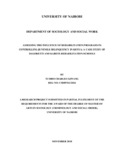| dc.description.abstract | Cases of crimes committed by juveniles have been increasing to the detriment of their
education and health while imposing stress on the judicial system. Juveniles have also
been reported to reoffend at high rates which has become a concern to the society. This
study examined the role of rehabilitation programmes in controlling juvenile delinquency
in Dagoretti and Kabete Rehabilitation schools. The study looked into the existing
rehabilitation programmes for juvenile delinquents, competency level of staff in handling
juvenile delinquents, policies and regulations in programmes and the social and economic
impacts of rehabilitation programmes on the juvenile delinquents. The role of these
centres has therefore not been clearly determined. This study was grounded on
Rehabilitation theory and Labeling theory. The study used descriptive survey design
method and utilized systematic random sampling to select 66 juvenile delinquents and 28
staff members. The study used questionnaires, key informant interviews, FGDs and
observation method to collect data. Descriptive statistical tools such as percentages and
frequency distributions were used to analyze quantitative data while qualitative data were
analyzed by content analysis. The study found that rehabilitation programmes for juvenile
delinquents were educational programmes, vocational programmes and counseling and
psychosocial services. The type of rehabilitation programme received by most juveniles
was primary school followed by bakery and confectionery, fashion and design and
masonry. The facilities which attracted the highest satisfaction were learning and training
facilities, classrooms and workshops and rules. Both the level of skills for staff and level
of satisfaction with education, skills and training of staff members in delivering
programmes were relatively high. The school rules were beneficial since they regulate
children’s behavior, maintain harmonious relationships and prepare children for
reintegration. Perception of both children and staff on effectiveness of the rehabilitation
programmes was mainly very high and good respectively. The benefits of rehabilitation
programmes were alleviating reoffending and adult criminality, behaviour modification
and providing access to education and skills training for employment opportunities. The
challenges that affected delivery of the rehabilitation programmes were inadequately
trained personnel, inadequate funding and staff, lack of parental involvement and
negative attitude from the community. The study recommends that Government should
provide adequate funds to support rehabilitation programmes in terms of employment of
more staff, in-service training, recruitment of counselors and psychologists and provision
of adequate classrooms, workshops, equipment and basic needs. Efforts should also be
made to provide juveniles with startup funds, working tools and assistance in marketing
their products. The Government through the judiciary should ensure that criminal
proceedings for juveniles are concluded speedily and promote good coordination between
social welfare and police department. Efforts should also be made to encourage parental
involvement and improve the community attitude on the juveniles. Further studies are
therefore recommended in the other rehabilitation schools in the country. More
information can also be obtained by benchmarking for best practices in rehabilitation
schools from other countries. | en_US |



